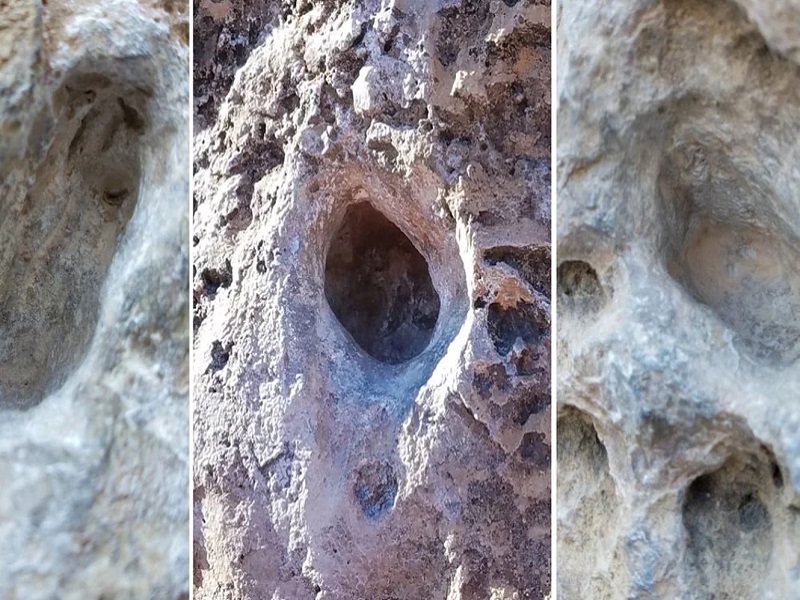
Chipped holds
PLEASE SHARE THIS WITH ANYONE WHO LOVES OUR NATURAL CLIMBING WALLS
To boil this letter down to bullet points for people skimming:
– Our natural climbing walls in Italy, Slovenia and Croatia are getting chipped, drilled, and glued to death
– It’s not a few routes, or a few holds, it is substantial manufacturing
– Reports from locals are of entire crags put up with heavy fabrication
– We want it to stop
The following is an open letter to the climbing community on ethics. We care deeply about our climbing areas, its history, and its future.
We regret not bringing these issues to your attention sooner, but have been torn on how to bring them forward until we understood the severity and had definitive proof. Over the past months we have received pleas from a number of climbers, often accompanied by photos of glue covered holds and what appear to be drilled pockets and chiseled features. A great deal of damage has been done in the area over the past and its extent is only now becoming clear to us. For the first time in history nearly fully manufactured routes (using what appears to be drill bits, chisels, and large amounts of glue) are being openly created and widely promoted. The extent of which is more akin to ‘route setting’ in an indoor gym than route development on natural rock.
This time we will not point out direct names of authors of this work neither the climbing areas, as the authors know very well who they are and they should stop this work immediately.
Don’t get us wrong, our growing community has experienced questionable ethics in the past, and we have all climbed on routes with a bolter’s dirty secret of an enhanced hold or two. In the eyes of many, developing limestone routes inherently contains some fuzzy grey areas of ethics because of how the rock is cleaned or dulled, but manufacturing holds to create whole crags isn’t a grey area. What once were isolated events of someone’s poor judgement have now become strategic planning on a larger scale to create “climbable walls.”
Our organization strongly opposes the intentional alteration or creation of new holds (ie. chipping, “drilled pockets”, gluing, etc). We firmly believe that these actions diminish the natural climbing resource, eliminate challenges for future generations of climbers, and most importantly, threaten access to climbing on public lands. It is our position that any manufacturing of holds is an unacceptable practice that is counter to the consensus, culture, and norms around ethical route development in the climbing community.
The ethic that has been followed since modern sport climbing as brought was to do the minimal amount of work to make the route climbable. The idea has always been to discover and equip the route that geological time has delivered us instead of creating movements on an open palate of blank malleable stone. Our nature is full of beautiful natural lines, and when those run out we need to stop bolting it. There are already 1000+ routes in the area. When will enough be enough?
We have now heard the excuses from the perpetrators that they were “trying to help create more moderates,” but there are hundreds of 4 and 5 star routes in all grades everywhere already. Are they not robbing from the future, when someone may have been able to climb that natural 9a?
With this new slide in ethics all conceivable walls could now be grid bolted and chiseled into submission. This leaves us scratching our heads and wondering if sport climbing ethics have shifted radically from under our noses. Is this acceptable and allowable in the modern era? What will young climbers think? Will they even care? What will land managers think? We have enough to worry about as we watch the impacts that the area’s growing popularity has, isn’t this just going to exacerbate the problem even more?
What also concerns us is that the ones currently doing the most unethical behavior so openly, are also encouraging other young climbers, who now think that this is how bolting is done. Are new bolters going to think that this is the way a crag is developed: by brute force? The area has more developers visiting every year now. We know that not every one of them utilizes the tactics that we are highlighting here and that it is really only a few developers who are involved to this degree, but our hearts grow heavy thinking these tactics becoming common practice and acceptable in the years to come. We wonder what the bolters are thinking. What are their motives? Why don’t they see the same dangers as us?
We have addressed these actions directly with some bolters. Our conversations with these folks have caused a whole array of reactions: unabashed acknowledgement, defensive name-pointing, erroneous normalization or deceitful denial. Some have just blatantly said “If you don’t like it climb somewhere else!” as though this was some kind of new normal that has to be accepted! Like the brain of a 4 years old kid thinking that (in this case a natural wonder) it is his own sandbox in which only his rules apply. For the rest, they could go play elsewhere if they don’t like it.
This statement is to make it clear that it is not normal and not accepted and it will not be hidden anymore.
Adam Ondra‘s comment in Climbing magazine: “Reinforcing a flake that barely holds its own weight is already creating an artificial hold for me.” His approach appears based in reducing human influence to the rock. Where glue will remain a fixture, the highly invasive process of choss removal leaves rock in modified but compositionally natural state. Chossy features break at their weakest points providing an almost excavation-like approach to route building. Those that follow this approach simply find the good rock underneath the loose material. While he refrains from describing a code of ethics, Ondra did take a stance on hold manufacturing malpractice. “Chipping is often seen as a thing of the past, but unfortunately, it is still present and it will definitely be an issue even in the future. I have nothing against climbing chipped routes from the past. They are part of climbing history and shouldn’t be changed, from a certain point of view. Unfortunately, there are still a lot of routes being put up every year with very obvious chipping. Even old-school, straight forward drilled pockets creating ladder-like climbs. I believe that is something that has to stop. Is it Ok to chip one hold to create a beautiful and homogenous 7b that a lot of climbers can enjoy instead of one move wonder 8b? My opinion is absolute clear – it should be the latter option.”
This is where we need your help:
We ask now for the climbing community’s support to protect the natural beauty and variety of our natural climbing walls. Promises that this won’t happen in the future are not enough.
Chipping is past, respect the nature!
To support this request please share this letter and comment below with any additional comments.

